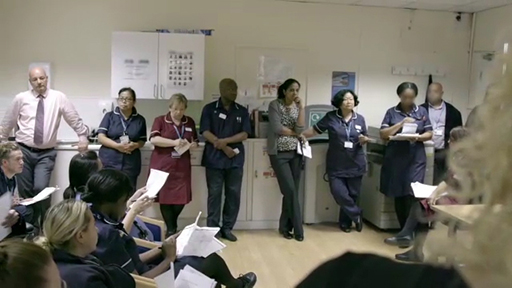1 Applying your learning: learning from medical staff
In 2016, the BBC were permitted to film in St Mary’s hospital in London to capture the day-to-day interactions of medical practitioners. The way they interact with each other and the public is illuminating for people working in sport and fitness.
Activity 1 Learning from medical staff
There are two clips in this video-related activity, which focus on sustaining relationships in a busy hospital. The first clip is the morning teleconference update, focusing on bed space in the hospital; the second is a preparatory meeting of a surgeon and their patient who is having a surgery to treat cancer.
There is a question for each clip:
Clip 1 (teleconference): To what extent is Lesley’s (Hospital Site Director) informal teleconferencing tone appropriate to sustaining working relationships?
Clip 2 (surgeon and patient): How successfully does Dr George Reese convey that he is patient-centred?

Transcript: Clip 1
[MUSIC PLAYING]

Transcript: Clip 2
Discussion
She uses an informal manner (e.g. ‘the gang at Charing Cross’; ‘you guys’). However, informal does not mean ineffective in sustaining relationships; the meeting is conducted briskly and the essential information is communicated. For example, notice how she closes the meeting by using the words ‘our focus’ to describe the immediate tasks ahead. The reminder of the time of the next meeting demonstrates clear task-related communication.
Dr Reese demonstrates his patient-centred approach by sitting at the same eye level as his patient; he smiles and updates his patient as to why there is a delay. He re-assures by saying ‘as soon as I know, you’ll know’ in relation to bed availability. He asks if his patient has any questions and remains unruffled when the issue of car parking costs is raised by the patient’s friend; he politely re-focuses the conversation.
By using this medical example you will be able to begin to make sense of how you and others maintain and perhaps build you own working relationships.

